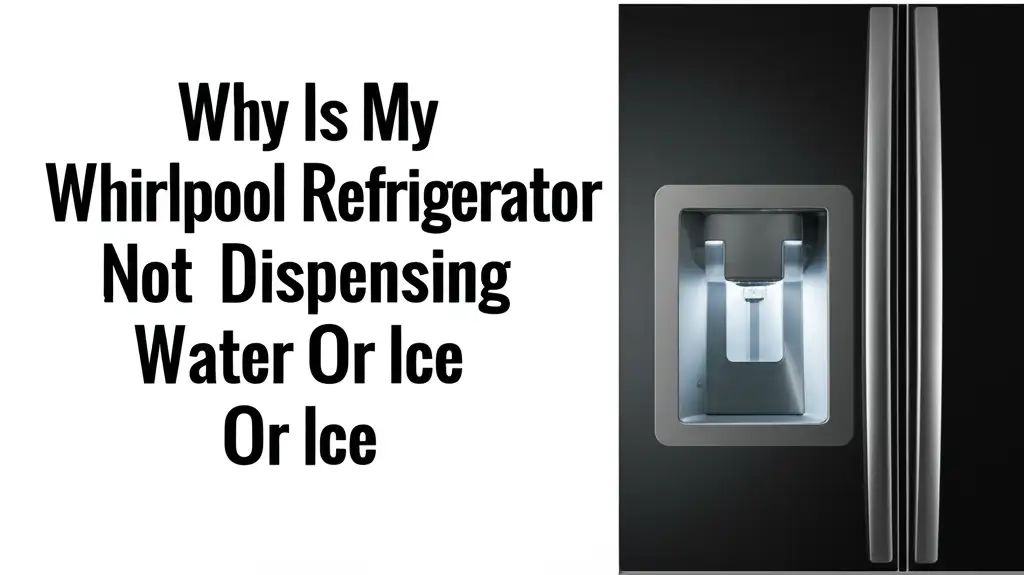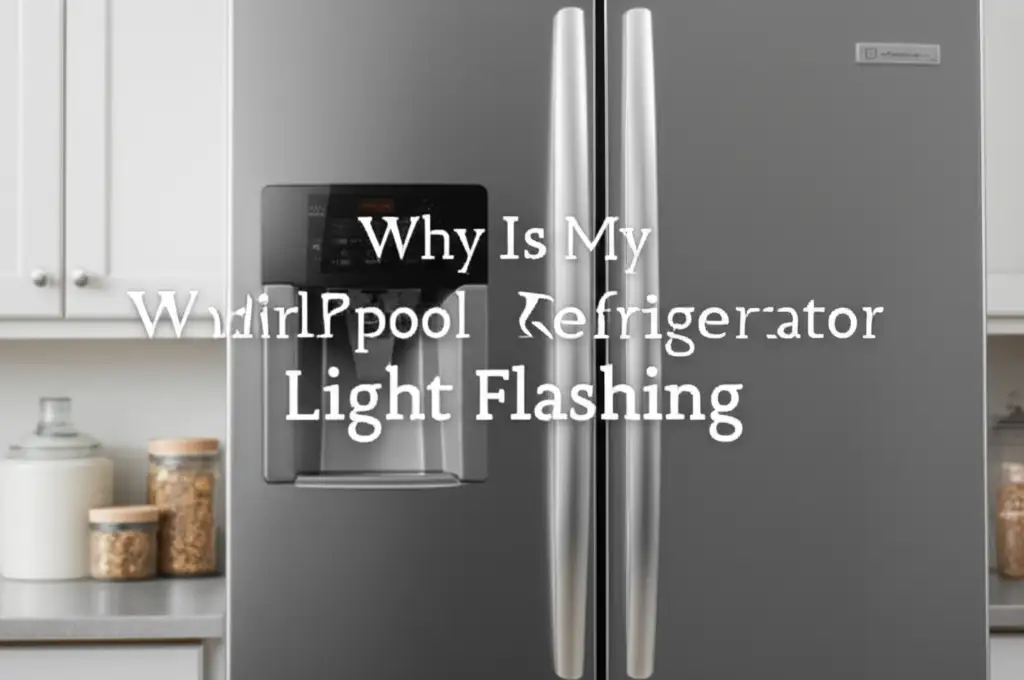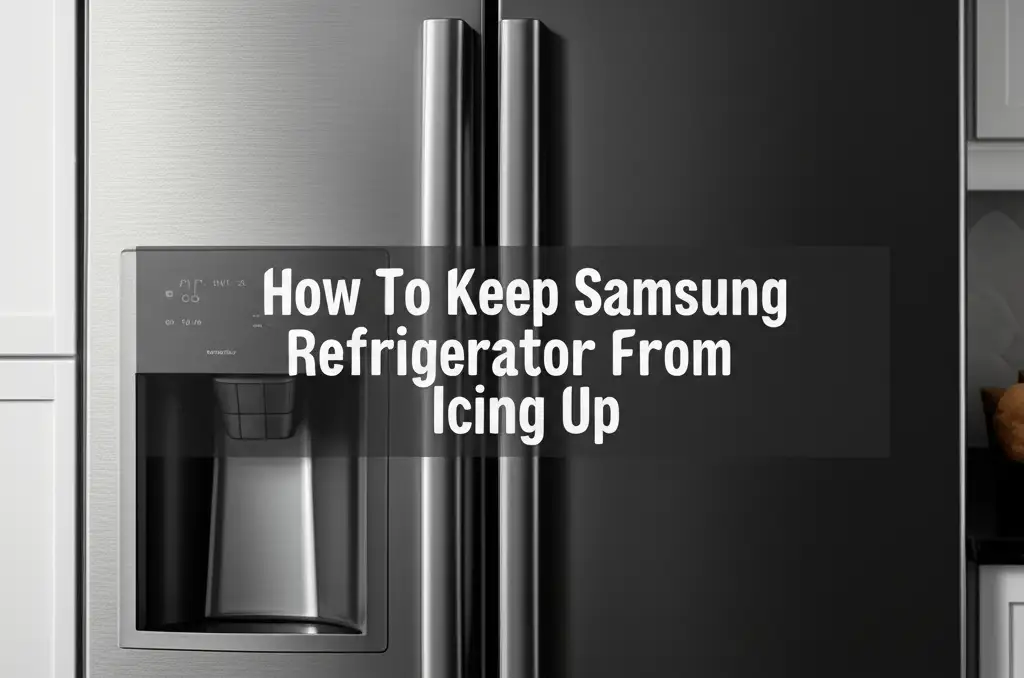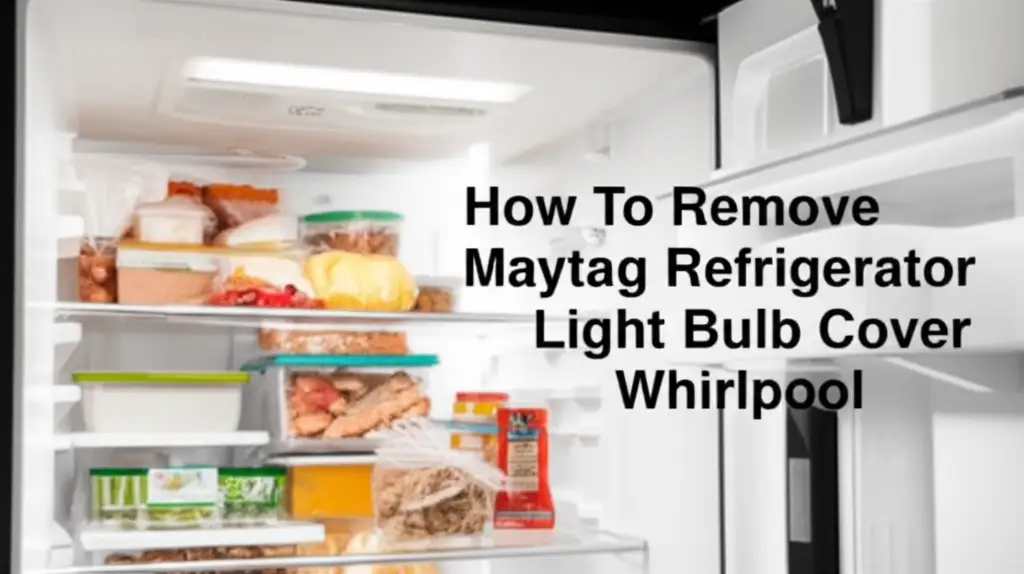· Davia Murnell · Refrigerator Care · 18 min read
Can I Use My Whirlpool Refrigerator Without The Water Filter
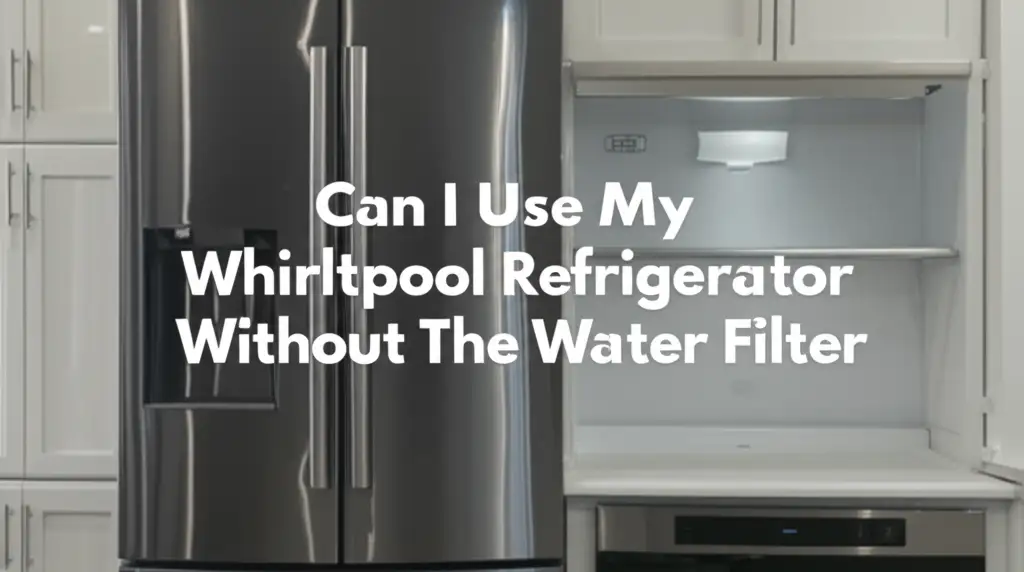
Using Your Whirlpool Refrigerator Without a Water Filter: What You Need to Know
Have you ever wondered if your Whirlpool refrigerator needs that water filter to function? It’s a common question many homeowners ask. Perhaps you forgot to replace it, or maybe you are trying to save some money. The good news is, your Whirlpool refrigerator can indeed dispense water and make ice without an active filter. However, choosing to operate without it brings specific considerations.
This article explores the practicalities of using your Whirlpool refrigerator without its water filter. We will discuss how your appliance works with or without it, the potential risks of unfiltered water, and the benefits the filter provides. You will also learn about alternative water purification methods and proper maintenance steps. Our goal is to provide clear information for you to make the best decision for your home and health.
Takeaway
Here are the key points for using your Whirlpool refrigerator without a water filter:
- You can operate your Whirlpool refrigerator without an active water filter by using a bypass plug.
- Unfiltered water can contain contaminants, affecting taste, smell, and potentially your health.
- Not using a filter may lead to sediment buildup, damaging your refrigerator’s internal components.
- Always use a bypass plug when removing the filter to prevent leaks and ensure proper water flow.
- Consider alternative filtration methods if you opt not to use the refrigerator’s built-in filter.
Yes, you can use your Whirlpool refrigerator without the water filter. To do this, you must install a water filter bypass plug in the filter’s place. This plug allows water to flow through the system to the dispenser and ice maker, avoiding the filter chamber entirely.
The Basics: Can You Really Use Your Whirlpool Refrigerator Without Its Filter?
Many people ask if they can use their Whirlpool refrigerator without a water filter. The simple answer is yes, you can. Whirlpool refrigerators are designed to operate even when the filter is not present. This is because the filter is an accessory, not a core component for water flow. The refrigerator’s plumbing system routes water whether a filter cleans it or not.
When you remove the water filter, a bypass plug must go into its slot. This plug ensures water flows correctly through the system. Without this plug, you could face leaks or no water dispense at all. It effectively “completes” the water circuit within the appliance. This bypass method is similar across many refrigerator brands. For example, Can I use my LG refrigerator without the water filter and Can I use my KitchenAid refrigerator without the water filter articles discuss similar concepts for those brands. This shows it is a common design feature.
Understanding the Bypass Plug
A bypass plug is a small, plastic component that comes with your Whirlpool refrigerator. Its purpose is to allow water to flow directly through the filter housing. It effectively seals the opening where the filter usually sits. This prevents water from leaking out. It also ensures proper pressure for the dispenser and ice maker. If you do not have your original bypass plug, you might need to order one from Whirlpool.
When to Consider Bypassing
You might consider bypassing the filter for several reasons. Perhaps your municipal water supply is already very clean. Some homeowners have a whole-house filtration system. In such cases, the refrigerator’s filter provides redundant filtration. You might also bypass it if you are waiting for a new filter to arrive. It allows you to continue using your water and ice dispenser in the interim. However, this is only a temporary solution if you plan on using filtered water. Knowing you can run your Samsung refrigerator without the water filter also provides peace of mind across brands.
Potential Risks and Downsides of Unfiltered Water
While you can technically use your Whirlpool refrigerator without a filter, doing so comes with risks. The primary purpose of the water filter is to remove impurities. These impurities exist in tap water, even if it looks clean. Bypassing the filter means you will get direct tap water. This water may contain various substances.
The water quality from your tap varies greatly by location. Some areas have very hard water. This water contains high levels of minerals like calcium and magnesium. Other areas might have older pipes. These pipes can introduce sediment or even lead into your water. Without a filter, these elements pass directly into your drinking water and ice. This can impact both your health and your appliance.
Health Implications of Contaminants
Drinking unfiltered water can expose you to a range of contaminants. These may include chlorine, sediment, rust, lead, cysts, and other microorganisms. Chlorine is often used to disinfect public water supplies. While it makes water safe, it can leave an unpleasant taste and smell. Long-term exposure to certain contaminants, like lead, can pose serious health risks. It is important to know what is in your local water. A filter acts as a barrier against these unwanted elements.
Impact on Taste and Odor
One of the most noticeable differences when using unfiltered water is the taste and smell. Water with high chlorine content often has a chemical odor. Water with high mineral content can taste “hard” or metallic. Sediment can give water a cloudy appearance. Ice cubes made from unfiltered water will also carry these tastes and odors. This can affect the flavor of your beverages and food. Many people prefer the crisp, clean taste of filtered water.
Appliance Wear and Tear from Sediment
Beyond taste and health, unfiltered water affects your refrigerator’s components. Sediment, rust, and mineral deposits can build up inside the water lines and ice maker. Over time, this buildup can clog narrow passages. It can also cause parts to corrode or wear out prematurely. This may lead to issues like your Whirlpool refrigerator not dispensing water or ice. It could also cause leaks from various parts of the appliance. A filter acts as the first line of defense. It protects the internal plumbing of your appliance.
How a Whirlpool Water Filter Protects Your Appliance and Health
Whirlpool water filters are more than just an accessory; they are a vital component for water quality and appliance longevity. These filters use activated carbon to trap impurities. This process improves the safety, taste, and smell of your drinking water. Installing a filter is a simple step that offers significant benefits. It helps ensure your family has access to cleaner water right from your refrigerator.
The design of Whirlpool filters targets specific contaminants common in tap water. Each filter is certified to meet certain standards. This means they are tested to remove or reduce specific substances. Knowing your water passes through such a filter provides peace of mind. It allows you to enjoy fresh, clean water without worry. Regularly changing your filter is also important to maintain its effectiveness. For insights on cleaning other types of filters, you might find information on how to clean a water filter helpful.
What Filters Remove
Whirlpool water filters are designed to remove a wide range of contaminants. These include chlorine taste and odor, lead, mercury, benzene, and specific pesticides. They also reduce cysts, which are microscopic organisms that can cause illness. The activated carbon block inside the filter acts like a sponge. It absorbs impurities as water passes through it. This multi-stage filtration process ensures high-quality output. Each filter type has specific reduction capabilities listed on its packaging.
Benefits Beyond Taste
The benefits of a water filter extend beyond just improving taste. Filters provide a safer drinking experience by reducing harmful substances. They also protect your refrigerator’s water system. Mineral buildup can clog lines and valves over time. This leads to reduced water flow or complete blockage. A filter prevents these deposits from entering the system. This saves you from costly repairs and maintenance. Clean water lines also prevent issues like your Whirlpool refrigerator not making ice but water works, ensuring all dispenser functions operate smoothly.
Extending Appliance Lifespan
By filtering out sediment and minerals, the water filter helps extend the life of your refrigerator. Less buildup means less strain on the dispenser and ice maker components. This reduces the likelihood of malfunctions. Regular filter replacement helps keep the water system running efficiently. This preventative measure contributes to the overall longevity and performance of your appliance. It helps avoid premature wear and tear on critical parts.
Common Issues When Operating Without a Filter
Operating your Whirlpool refrigerator without its water filter can lead to several noticeable problems. These issues typically stem from the quality of the unfiltered tap water. They can affect both the performance of your appliance and your experience using it. Understanding these potential challenges helps you weigh the pros and cons of bypassing the filter.
The immediate effect you might notice is a change in the water’s taste and smell. Beyond that, the lack of filtration can impact the internal workings of your refrigerator. Sediment and mineral deposits, normally caught by the filter, now freely enter the water lines. This can create blockages and reduce efficiency over time. It can also compromise the purity of your ice.
Dispenser Problems and Clogs
One of the most frequent issues is reduced water flow from the dispenser. Sediment and mineral deposits can accumulate in the narrow water lines. This buildup acts like a blockage. It restricts the amount of water that can pass through. Eventually, this can lead to slow dispensing or no water at all. Clogs can also affect the solenoid valves. These valves control water flow to the dispenser and ice maker. If they become fouled, they may not open or close properly. This can cause various Whirlpool refrigerator not dispensing water or ice problems.
Ice Quality Degradation
Without a water filter, the ice cubes your Whirlpool refrigerator produces will likely suffer in quality. They may appear cloudy or have a milky look. This is due to dissolved minerals and impurities present in unfiltered water. These impurities become concentrated as the water freezes. You might also notice an unpleasant taste or odor in your ice. This will affect the flavor of your drinks. In some cases, increased sediment can even lead to your Whirlpool side-by-side refrigerator not making ice effectively.
Unpleasant Smells and Flavors
The most direct impact on your sensory experience will be the smell and flavor of the water and ice. Unfiltered tap water often contains chlorine, which can give it a distinct chemical smell and taste. Other contaminants like rust, sulfur, or even tiny organic particles can also impart undesirable flavors. These flavors transfer directly to your dispensed water and ice. This makes them less enjoyable to drink. Many find this change significant enough to reconsider bypassing the filter.
Alternatives to Using the Built-In Filter
If you decide not to use your Whirlpool refrigerator’s built-in water filter, you still have options for clean drinking water. Many alternative filtration methods exist. These can provide purified water without relying on your appliance’s internal system. Choosing an alternative depends on your budget, water quality needs, and personal preferences.
Exploring external filtration solutions can be a smart move. They often provide comprehensive filtration for your entire home. Or they can target specific points of use like your kitchen sink. This flexibility allows you to customize your water purification strategy. It also ensures you get the clean water you desire.
Whole-House Filtration Systems
A whole-house filtration system is an excellent alternative. It filters all water entering your home. This means every tap, shower, and appliance receives filtered water. These systems are installed where the main water line enters your house. They offer comprehensive protection against sediment, chlorine, and other contaminants. With a whole-house filter, your refrigerator’s water dispenser will receive already purified water. This makes the refrigerator’s internal filter redundant. This is a great choice if you want clean water throughout your entire home.
Under-Sink Water Filters
Another popular option is an under-sink water filter. These systems are installed directly beneath your kitchen sink. They provide filtered water specifically for your drinking and cooking needs. The filtered water comes from a dedicated faucet next to your main sink faucet. This method offers a cost-effective way to get high-quality drinking water. It avoids the need for a refrigerator filter. These systems are typically easy to install and maintain. They can offer filtration levels similar to or better than refrigerator filters.
Filter Pitchers and Dispenser Bottles
For a simpler, more portable solution, consider filter pitchers or large dispenser bottles. These use gravity to filter water. You simply pour tap water into the pitcher, and it passes through a carbon filter. This method is the least expensive. It requires no installation. It is ideal for small households or those who only need filtered water for drinking. While convenient, it does not provide continuous filtered water on demand like a refrigerator dispenser. You must refill the pitcher regularly.
When and How to Properly Bypass the Filter
Bypassing your Whirlpool refrigerator’s water filter is a straightforward process. However, it requires a specific component: the bypass plug. This small but crucial part ensures your refrigerator functions correctly without the filter. It prevents leaks and maintains the water flow to the dispenser and ice maker. You should only bypass the filter if you have this plug available.
Proper installation of the bypass plug is key. It ensures no water escapes from the filter housing. Ignoring this step can lead to water damage in your kitchen. Always refer to your refrigerator’s owner’s manual for model-specific instructions. The general steps are similar across most Whirlpool models. Knowing how to correctly handle filter changes, even bypassing, can be helpful for various brands, as seen with instructions like can you change Samsung refrigerator water filter without turning off water or can you change an LG refrigerator water filter without turning off water.
Locating Your Whirlpool Bypass Plug
Most Whirlpool refrigerators come with a bypass plug. It is typically a small, plastic cylinder. It matches the size and shape of the water filter. Often, it is stored in a small compartment inside the refrigerator. Check the owner’s manual for its exact location. If you cannot find it, you can order a replacement directly from Whirlpool or an appliance parts supplier. Do not attempt to operate the refrigerator without either a filter or a bypass plug installed.
Step-by-Step Installation
- Turn off the water supply: Locate the water shut-off valve behind your refrigerator or under your sink. Turn it clockwise to stop the water flow. This prevents leaks during the process.
- Remove the old filter: Open the filter housing door. Twist or pull the old filter according to your model’s instructions. Expect a small amount of water to drip out. Have a towel ready.
- Insert the bypass plug: Take the bypass plug. Align it with the filter housing. Push or twist it into place until it clicks or locks securely. Ensure it sits flush with the housing.
- Restore water supply: Slowly turn the water shut-off valve counter-clockwise to restore water flow. Check for any leaks around the filter housing.
- Flush the system: Dispense water from your refrigerator for about 3-5 minutes. This purges any air from the lines. It also ensures proper water flow. Discard the first few batches of ice as well.
Important Considerations
Always ensure the bypass plug is fully seated. A loose plug can cause leaks. Check for leaks immediately after restoring water. Monitor the area for a few hours. If you notice any drips, turn off the water supply and re-seat the plug. Remember, using a bypass plug means your water and ice will be unfiltered. Consider this if your local water quality is poor.
Maintaining Your Whirlpool Refrigerator Without a Filter
Even without a water filter, your Whirlpool refrigerator still needs regular care. Bypassing the filter means more sediment and minerals might enter your appliance’s water lines. This increases the importance of specific maintenance tasks. Proper cleaning and inspection can prevent buildup and ensure the longevity of your refrigerator. It helps keep your water and ice dispensing systems operating smoothly.
Neglecting maintenance when not using a filter can lead to various problems. These include reduced water flow, clogged ice makers, and even potential leaks. Regular cleaning can minimize these risks. It helps you keep your appliance in good working order. Additionally, general how to clean the refrigerator practices are always beneficial.
Regular Cleaning of Dispenser and Ice Bin
When you do not use a filter, more impurities may accumulate in your dispenser. This includes the water tray and ice bin. Clean the dispenser tray regularly to prevent mildew and mineral stains. Use a mild soap and warm water. For the ice bin, empty and wash it periodically. This removes any mineral deposits or odd smells that might accumulate in the ice. A clean ice bin helps ensure your ice is fresh.
Monitoring Water Line for Sediment Buildup
Without a filter, sediment can build up in the refrigerator’s internal water lines. While you cannot easily clean these lines, you can monitor for signs of buildup. Look for reduced water flow from the dispenser. Also, watch for cloudy ice or unusual noises from the water valve. If you suspect significant buildup, professional service might be needed. Sometimes, flushing the system by dispensing a large amount of water can help.
Addressing Leaks or Odd Noises
If you bypass the filter, always be vigilant for leaks. Any water around the filter housing or underneath the refrigerator needs immediate attention. Leaks can indicate improper bypass plug installation or other issues. Unfiltered water might also cause mineral deposits to form on valves, leading to strange noises. For example, a buzzing or vibrating sound when water is dispensed could point to a valve struggling with buildup. If you notice leaks, especially from the bottom of your side-by-side refrigerator, this article on why is my Whirlpool side-by-side refrigerator leaking water from the bottom might offer some insights into common causes, even if not directly filter-related. Address any leaks or unusual noises promptly to prevent further damage.
FAQ Section
Does bypassing the filter void my Whirlpool warranty?
Generally, bypassing the water filter with a bypass plug does not void your Whirlpool refrigerator’s warranty. The filter is a consumable item. The warranty covers manufacturing defects in the appliance itself. However, damage caused directly by operating the unit without a filter, such as mineral buildup leading to component failure, might not be covered. Always check your specific warranty terms.
Will my Whirlpool refrigerator dispense water faster without a filter?
Yes, your Whirlpool refrigerator may dispense water slightly faster when the filter is bypassed. Water filters naturally restrict flow to some extent as water passes through the filtration media. Removing this restriction allows water to flow more freely. This can result in a noticeable increase in dispensing speed and pressure.
What is a water filter bypass plug for?
A water filter bypass plug is a small component designed to replace the water filter in a refrigerator. Its purpose is to allow water to flow through the filter housing directly. This ensures the water dispenser and ice maker continue to operate when no filter is installed. It also prevents leaks from the filter housing.
How often should I clean my water lines if I don’t use a filter?
You cannot easily clean the internal water lines of your refrigerator. Instead, focus on preventive measures. Regularly clean the dispenser tray and ice bin to remove mineral buildup. If you notice a significant decrease in water flow or cloudy ice, it may indicate sediment buildup. In such cases, professional assistance might be needed to flush the system.
Can I put a dummy filter in my Whirlpool refrigerator?
A “dummy filter” is essentially what a bypass plug is. It allows water to flow without filtration. Some after-market products may be marketed as dummy filters. However, it is best to use the official Whirlpool bypass plug. This ensures a proper fit and prevents leaks. Using anything not designed for your specific model could damage the appliance.
Conclusion
You can indeed use your Whirlpool refrigerator without its water filter. By installing a bypass plug, water will flow to your dispenser and ice maker. This provides a temporary solution or a permanent option if you have alternative filtration methods. However, this choice comes with important considerations. You should understand the risks involved.
Operating without a filter exposes you to unfiltered tap water. This may contain impurities that affect taste, smell, and potentially your health. It also increases the risk of sediment and mineral buildup within your refrigerator’s water lines. This can lead to clogs and reduce the lifespan of your appliance. A Whirlpool water filter plays a vital role in ensuring water quality and protecting your refrigerator’s internal components. If you choose to bypass the filter, consider investing in a whole-house or under-sink filtration system for clean drinking water. Always ensure the bypass plug is correctly installed to prevent leaks. Regular cleaning of your dispenser and ice bin is also crucial for maintaining hygiene and preventing buildup. Your decision to use your Whirlpool refrigerator without the water filter depends on your water source quality and your preference for filtered water. Make an informed choice to ensure both your health and your appliance’s longevity.
- Whirlpool refrigerator
- water filter bypass
- refrigerator maintenance
- unfiltered water
- appliance tips
- home water quality


